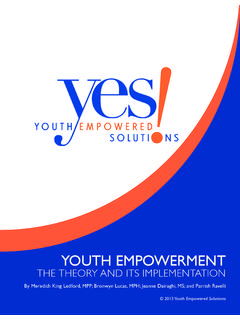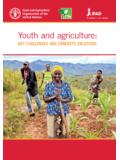Transcription of Toward a Critical Social Theory of Youth …
1 Toward a Critical Social Theoryof Youth EmpowermentLouise B. Jennings, PhDDeborah M. Parra-Medina, MPH, PhDDeAnne K. Hilfinger Messias, PhD, RNKerry McLoughlin, article contributes to the development of a criticalsocial Theory of Youth empowerment which emphasizes collective ef-forts to create sociopolitical change. It draws upon analysis of four youthempowerment models, and upon findings from a participatory researchLouise B. Jennings is Associate Professor, Department of Educational Psychology,University of South Carolina, Columbia, SC 29208 (E-mail: M. Parra-Medina is Associate Professor, Department of Health Promotion,Education, and Behavior, Arnold School of Public Health, and Women s Studies De-partment, University of South Carolina, Columbia, SC 29208 (E-mail: DeAnne K. Hilfinger Messias is Associate Professor, College of Nursing andWomen s Studies Program, University of South Carolina, 201 Flinn Hall, Columbia,SC 29208.))
2 Kerry McLoughlin is Qualitative Research Analyst, Family Health Interna-tional, Durham, NC 27713 (E-mail: authors acknowledge the contributions of Elizabeth Fore, Sherer Royce, andTerry manuscript was developed through a grant from the American Legacy Founda-tion with collaboration from the CDC Foundation, and scientific and technical assistancefrom the Centers for Disease Control and Prevention. The Grantee s Informational Mate-rials do not necessarily represent the views of the American Legacy Foundation or theCDC Foundation, their respective Staff or their respective Board of Directors.[Haworth co-indexing entry note]: Toward a Critical Social Theory of Youth empowerment . Jennings,Louise B. et al. Co-published simultaneously inJournal of Community Practice(The Haworth Press, Inc.)Vol. 14, No. 1/2, 2006, pp. 31-55; and: Youth Participation and Community Change(ed: Barry , and Lorraine M. Guti rrez) The Haworth Press, Inc.)
3 , 2006, pp. 31-55. Single or multiple copiesof this article are available for a fee from The Haworth Document Delivery Service [1-800-HAWORTH, 9 - 5:00 (EST). E-mail address: online at 2006 by The Haworth Press, Inc. All rights which identified key dimensions of Critical Youth empowerment :(1) a welcoming, safe environment, (2) meaningful participation and en-gagement, (3) equitable power-sharing between Youth and adults, (4) en-gagement in Critical reflection on interpersonal and sociopoliticalprocesses, (5) participation in sociopolitical processes to affect change,and (6) integrated individual- and community-level empowerment . Itconcludes with discussion of the measurement of outcomes, and thechallenges and opportunities for empowerment in Youth organization.[Article copies available for a fee from The Haworth Document Delivery Ser-vice: 1-800-HAWORTH. E-mailaddress: < > 2006 by The Haworth Press,Inc.]]
4 All rights reserved.] , Youth empowerment , model development, par-ticipatory research, Critical Social theoryINTRODUCTIONE fforts to support youths healthy development and integration intothe community have experienced several shifts in focus over the pastfew decades (Small, 2004). Historically, a primary function of youthprograms was rehabilitation or containment ( , keeping Youth offthe streets). An initial shift from these risk-based preventive ap-proaches was in the direction of fostering healthy Youth developmentand capacity building through active community participation (Kim,1998; Small, 2004). More recently, positive Youth development ap-proaches have been expanded to incorporate a focus on Youth is a multi-level construct consisting of practical ap-proaches and applications, Social action processes, and individual andcollective outcomes. In the broadest sense, empowerment refers to indi-viduals, families, organizations, and communities gaining control andmastery, within the Social , economic, and political contexts of theirlives, in order to improve equity and quality of life (Rappaport, 1984;Rappaport, 1987; Zimmerman, 2000).
5 The concept of empowermenthas been addressed at both theoretical and practice levels in specificreference to aim of this paper is to contribute Toward the development of acritical Social Theory of Youth empowerment . We begin with a theoreti-cal overview of empowerment and an examination of four conceptual32 Youth PARTICIPATION AND COMMUNITY CHANGE models of Youth empowerment identified through an extensive reviewof the literature, from multiple disciplinary perspectives. While recog-nizing that additional research examines dimensions of Youth empow-erment and informs our analysis of these models ( , Heath, 1991;Heath, 1994), we focused our search and examination specifically onconceptual models of Youth on our analysis of these existing models and our participa-tory research, we identify and discuss six essential dimensions of Criti-cal Youth empowerment (CYE). We propose CYE as a conceptualframework based on the integration of Youth empowerment processesand outcomes at the individual and collective levels.
6 These occur withinwelcoming, Youth -centered environments, through meaningful engage-ment and knowledge, skill, and leadership development, Critical reflec-tion on societal forces and power relations, and active communityparticipation, leading to change in sociopolitical processes, structures,norms, or images. The final sections present our discussion of the chal-lenges and opportunities for incorporating the dimensions of CYEwithin Youth organizations, issues of measurement, and potentialbenefits of CYE for Youth and OF Youth EMPOWERMENTE mpowerment is a Social action process that can occur at multiple lev-els, , individual, family, organization, and community. Theorists andresearchers across multiple disciplines have examined and analyzedempowerment and linked it to individual and collective health, well-be-ing, and environments (Freire, 1970; Jones, 1993; Pinderhughes, 1995;Rappaport, 1987; Wallerstein, 1992; Zimmerman, 1988).
7 Rocha (1997)proposed empowerment as a continuum or ladder, with Atomistic Individ-ual empowerment (focus on changing the individual) and Political Em-powerment (focus on changing the community) as the two endpoints. Sucha continuum focuses on only one dimension of empowerment the level orsubject (individual vs. collective). At the individual level, psychologicalempowerment focuses on individual-level capacity-building, integratingperceptions of personal control, a proactive approach to life, and a criticalunderstanding of the sociopolitical environment (Zimmerman, 1995;Zimmerman, 2000). Collective empowerment occurs within families, or-ganizations, and communities, involving processes and structures that en-hance members skills, provide them with mutual support necessary toeffect change, improve their collective well-being, and strengthen intra-Jennings et inter-organizational networks and linkages to improve or maintain thequality of community Youth empowerment as a bipolar continuum doesnot reflect other key dimensions of this complex Social action process,such as the philosophy and values underlying Youth programs and ini-tiatives, the dynamics of Youth -adult relationships within these initia-tives, and individual and collective processes of Critical reflection andreflective action to address Social injustice and inequities.
8 Rissel (1994)emphasized the integrated and sociopolitical dimensions of empower-ment, noting that community empowerment includes a raised level ofpsychological empowerment among its members, a political actioncomponent in which members have actively participated, and theachievement of some redistribution of resources or decision making fa-vorable to the community or group in question (p. 41). In the followingsections we examine four models, both theoretical and practice-based,that have been developed to explain and guide Youth empowermentefforts within empowerment CycleThe Adolescent empowerment Cycle (AEC) is a model developedby Chinman and Linney (1998). The AEC is based on psychologicaltheories of adolescent development and describes processes aimed atpreventing a sense of rolelessness and enhance self-esteem. Chinmanand Linney linked AEC to the developmental process of Social bonding,leading Youth to bond to positive institutions through action, skill devel-opment, and reinforcement.
9 Positive Social bonding can prevent youthengagement in negative Social activities. Given its theoretical basis, theAEC centers on three dimensions:adolescent participation in meaning-ful activities, such as community service, that provideopportunities forskill developmentandpositive reinforcement and recognition fromadultsthroughout the process. The authors argued that for adolescentsexperiencing a period of identity crisis and formation, participation inmeaningful activity may contribute to role stability, offsetting a generallack of purpose or direction many adolescents and Linney (1998) offered the example of older high schoolstudents mentoring incoming freshmen regarding their transition tohigh school as an illustration of how the processes of the AEC might berealized. They noted that participation in peer mentoring activitiescould provide adolescents with meaningful roles and organizational andcommunication skills that will be useful in later life.
10 Positive recogni-34 Youth PARTICIPATION AND COMMUNITY CHANGE tion by adults of the Youth mentoring roles and activities would havebeneficial implications for youths maturing self-esteem and self-effi-cacy. However, the authors did not provide details about youths rolesand responsibilities nor did they describe how adults engage in this pro-cess with positive reinforcement, a Critical feature of the AEC Development and empowerment Program ModelThe aim of the Youth Development and empowerment (YD&E) is toguide Youth empowerment initiatives within the context of substanceabuse prevention programs (Kim, 1998). Similar to the AEC model, theYD&E goes beyond the prevention of risky behaviors and is based onmeaningful participation of Youth in community service projects. A keyto the YD&E process is the enhancement of positive Social bonding andpreparation for participation and involvement in the socioeconomic andpublic affairs of the community.





